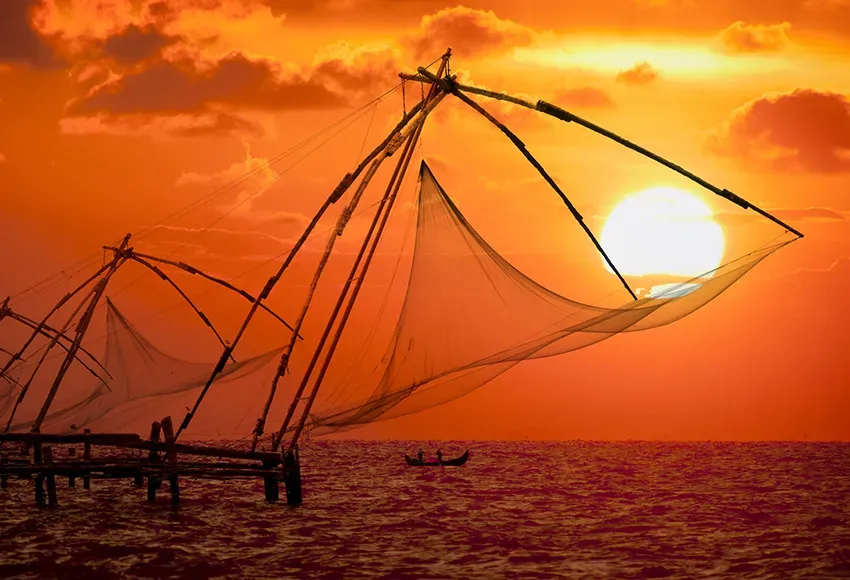Reprinted through the SGN's partnership with the National LGBT Media Association.
As I'm packing my bags to return to India to visit my girlfriend's family, I spend some time revisiting my trip there in 2019–20, right before the COVID pandemic. While sorting through interviews and photos, I am transported back to that amazing journey. (I only hope this trip will be just as wonderful!)
On Christmas Day 2019, my girlfriend and I boarded a plane for India to celebrate her parents' 61st wedding anniversary at the turn of 2020, and for me to meet her extended family for the first time. (Late fall and winter are the best times of the year to visit. The weather is perfect: it's warm and balmy in the south and chilly in the north. Many people travel to India for Diwali, the Hindu festival of lights, in the fall, and Holi, the festival of colors, in the spring.)
I was also going to meet with LGBTQ travel experts and activists for stories for international news articles and to learn more about the state of the LGBTQ movement in the country. In 2018, India's Supreme Court struck down the British colonial-era antisodomy law, Section 377. The law was often used to criminalize LGBTQ people, especially Gay and Bisexual men. It was actually the second time Section 377 was struck down: the Delhi High Court first did so in 2009, but India's Supreme Court reinstated the law in 2013.
Also, at the end of 2019, India's parliament passed several controversial laws that impacted the Transgender community: the Transgender Persons (Protection of Rights) Bill, (https://prsindia.org/billtrack/the-transgender-persons-protection-of-rights-bill-2019), two national citizenship laws (https://blogs.cul.columbia.edu/global-studies/2020/12/10/citizenship-amendment-act-caa-and-national-register-of-citizens-nrc), and two amendments those laws (https://www.hrw.org/news/2020/04/09/india-protests-attacks-over-new-citizenship-law). These laws largely affected all non-Hindu people living in India, but also LGBTQ people, especially Transgender people, due to not having proper government IDs for various reasons. The laws prompted some deadly protests.
It's the perfect time for India
Planning an LGBTQ trip to India, even for the skilled traveler and journalist I have become, has its challenges. In the past – and even now – there are tour operators and hotels that said they were LGBTQ-friendly but turned out only to be after the pink rupee (i.e., pink dollar), falling short on how to handle LGBTQ travelers' needs once they are actually on the tour.
Finding India's Queer community and businesses, especially for Queer women, is getting easier in India's most populous cities: New Delhi, the capital, and Mumbai, its financial center. Outside these hubs, though, finding community continues to be a challenge, because businesses aren't publicly out for safety and financial reasons.
However, over the last 15 years, India has been opening up to Queer Western travelers. Since 2009, some LGBTQ travel companies, both Indian- and foreign-owned, have paved the way by planning legitimate LGBTQ-welcoming packaged trips.
In 2020, the International Gay and Lesbian Travel Association (https://www.iglta.org) launched its India Task Force (now the India Initiative), of which I'm a member. The initiative is making headway into opening India to Queer travelers. In February, IGLTA hosted its first India LGBTQ travel symposium at LaLiT New Delhi, operated by Keshav Suri, a Gay man who was one of the plaintiffs in the case that repealed Section 377. He was also appointed the new chair of the India Initiative. The hotel's nightclub, Kitty Su (https://www.kittysu.com), hosts drag shows and Gay DJs on specific nights.
"It's the perfect time to come" to India, because the country is opening up to LGBTQ people and offers diverse experiences, from culinary ones to wildlife, wrote Robindro "Robin" Saikhom, a Gay man who is the founder of Serene Journeys (https://serenejourneys.co), one of the Indian Gay-owned travel companies, in an email interview with the Bay Area Reporter.
"India has virtually everything the world traveler is looking for, all set in a festive, friendly environment," he added.
Planning and itinerary
I selected New Zealand–based Out in India (https://www.outinindia.com) to help me plan most of my trip in India. I also booked an eight-day Golden Triangle tour through Intrepid Travel (https://www.intrepidtravel.com/us), which started in New Delhi and traveled to Jaipur, known as the "Pink City," and the Taj Mahal in Agra. Intrepid Travel launched a women-only tour (https://www.intrepidtravel.com/us/india/india-womens-expedition-145282) in 2020.
To travel to India, Americans need a visa. I used a service, like Atlys (https://www.atlys.com) or iVisa (https://www.ivisa.com), but to save money, skip the additional administrative fee on top of the visa fee and get an e-visa directly from the Indian Consulate. This can take 24-48 hours.
My girlfriend and I traveled to Mumbai, Pune, and Nashik in the Indian state of Maharashtra and Kochi (also known as Cochin) in the state of Kerala. I traveled on my own to Rajpipla in the state of Gujarat, and then to New Delhi, before joining the tour.
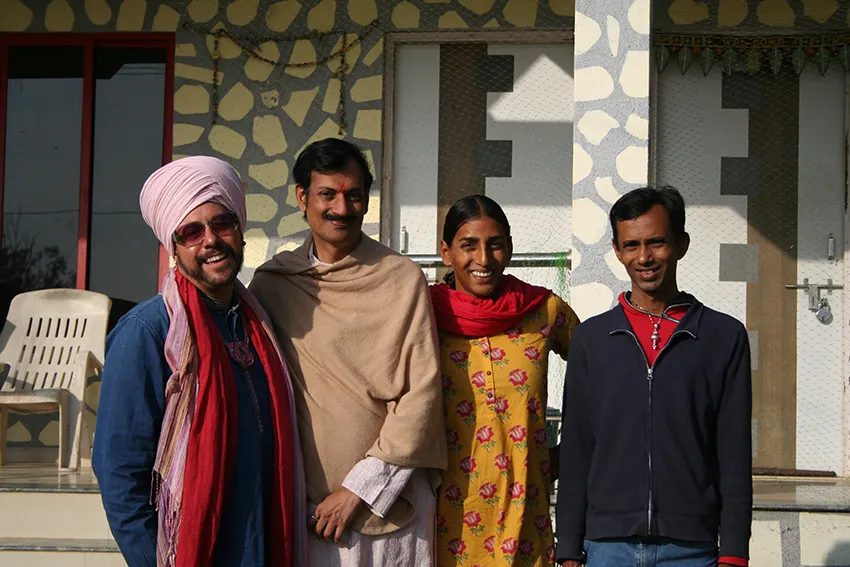
Unforgettable adventure
Traveling through India for five weeks was one of the best journeys I've ever experienced. I was taken in by the busy streets, the blend of spices that waft into the air from markets and restaurants, the juxtaposed poverty and wealth, the art and culture, the layers of history, and the friendliness and warmth of the people. I enjoyed meeting many LGTBQ Indians and learning about their fight for equal rights and their hopes for the future of their movement and country.
India is truly an unforgettable adventure.
My girlfriend and I found a country growing into its modern identity, a fusion of old India and the Western world, while keeping its native and colonial history. We found ourselves turning corners and eating at restaurants that made us question if we were in India at all, and then being reminded around another corner that we were very much there.
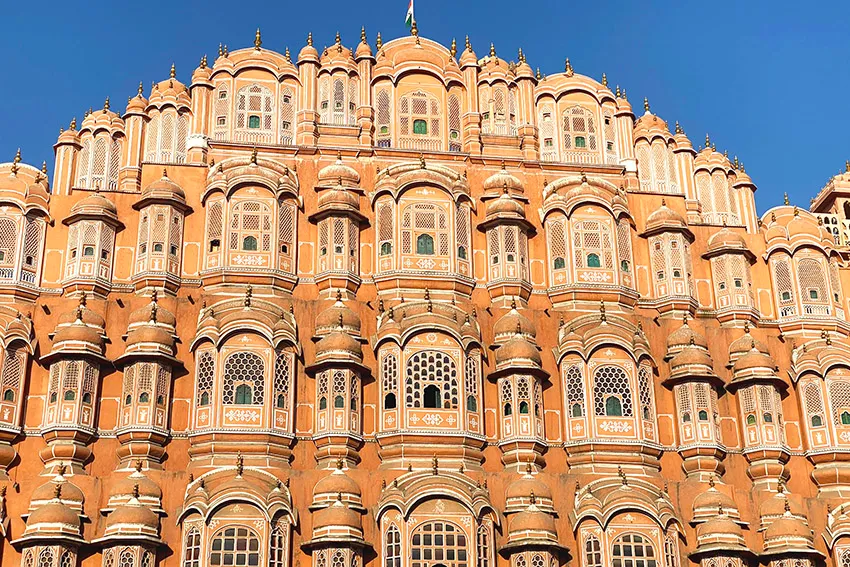
Art, culture, and history
India has a layered history from centuries of invasions, from the Mughals and the British, and people escaping persecution, such as the Parsis from Iran. Each community left its mark on the artistry, design, and architecture of ancient and present-day India. In its cities – from the palaces and country clubs of the British Raj to the temples and edifices of the Mughals – art and history were etched in stone and evident in the engineering of each building. It was breathtaking and overwhelming at times and also thought-provoking.
I couldn't have gone on my first trip without seeing the Taj Mahal (https://whc.unesco.org/en/list/252) in Agra. The ivory Mughal mausoleum lives up to its hype and its impressive history. Perched above the Yamuna River, it is stunning at sunset, when the marble gets that golden glow captured in thousands of photos, but nothing will ever beat seeing it in real life.
Not as impressive, but close, is the Hawa Mahal (Pink Palace) in Jaipur (https://www.hawa-mahal.com). It was built out of red and pink sandstone in 1799 and is an extension of the Royal City Palace, meant for women of the royal court to enjoy peering out onto city life without being seen.
There is also the mystical appearance of Jal Mahal ("Water Palace") (https://www.tourism.rajasthan.gov.in/jaipur.html), set atop the water, as if it is floating in the middle of Man Sagar Lake. It is believed to be a former summer palace of the royals built in 1699.
The Amber Fort (https://www.tourism.rajasthan.gov.in/amber-palace.html), built in 1592 out of red sandstone, rests on top of a hill over the small town of Amer.
In New Delhi, I enjoyed visiting the Lotus Temple (https://bahaihouseofworship.in) and the famous Sikh Sheeshganj Gurudwara temple (https://dsgmc.in/DharmParchar/GurdwaraSisGanjSahib), where 10,000 people are fed daily.
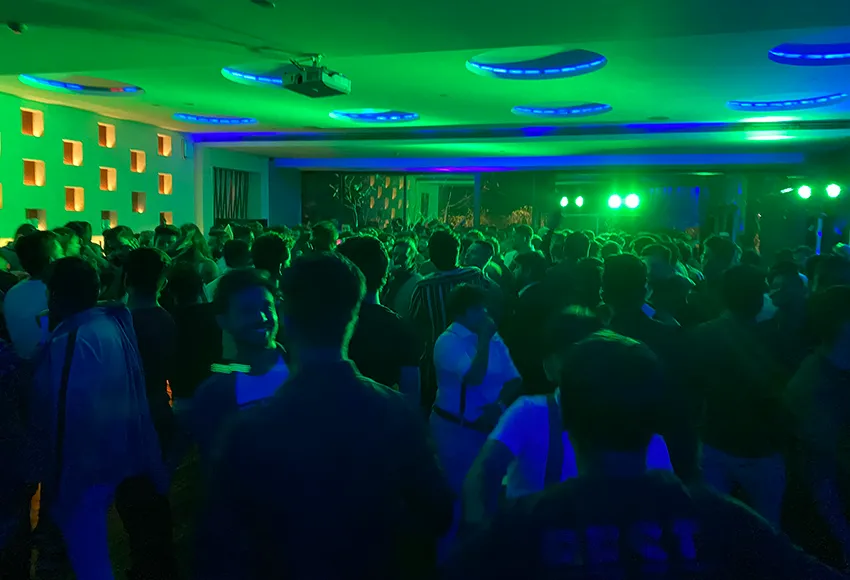
Queer India
Never in her wildest dreams did my girlfriend believe she would kiss her significant other at a Queer party in her father's hometown, she told me. Yet, on New Year's Eve 2020, we were surrounded by more than 700 LGBTQ partygoers at a party by Mist LGBTQ Foundation (https://www.facebook.com/MistLGBT) to ring in the new year and decade at the Hyatt Pune. At the stroke of midnight in a crowded room, we clinked glasses and locked lips.
India's LGBTQ community is vibrant, creative, and full of life. In Mumbai, I spent a fun evening at a lively Queer trivia night hosted by Gaysi Mumbai (https://gaysifamily.com), an LGBTQ group that promotes Queer events, at the Independence Brewery Company (https://www.independencebrewco.com) in Andheri West.
One of the wonderful things about India is its art, culture, and literary scene. I was pleased to discover LGBTQ artists and art experts, like Kalki Subramaniam, a Transgender woman who is the founder and director of Sahodari Art Gallery (www.sahodari.org), which features 45 LGBTQ artists, mostly Transgender people. The gallery is located about four hours outside of Kochi by car.
In Mumbai and New Delhi, I learned about the city's LGBTQ art scene and history with Gay art historian Aditya Ruia, the owner of Bombay Art Gallery (https://www.linkedin.com/in/aditya-ruia-0464ba60/?originalSubdomain=in). Ruia also leads an LGBTQ art tour in Mumbai.
One memorable night in Mumbai, I happened to tour Colaba's Art Deco architecture, art galleries, and boutiques with filmmaker Faraz Arif Ansari (https://www.facebook.com/farazarifansari).
In New Delhi, Serene Journeys' Saikhom leads guests past about 55 public murals on the Lodhi Art Public Art Tour (https://serenejourneys.co/blog/lodi-art-district-may-2019-2).
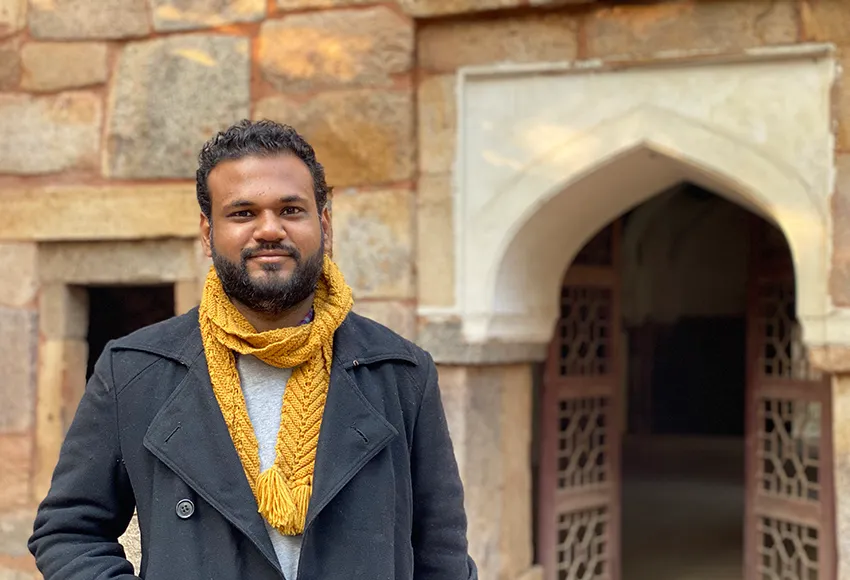
Sambhav Dehlavi, the Gay owner and tour guide of Purani Dilliwala Iqbal (https://www.instagram.com/puranidilliwalaiqbal), leads an LGBTQ history tour through the city, one of the most memorable of my trip. One of the sites he showed me was a tomb of a king and his male or Transgender lover, both buried side by side. There were many other sites throughout New Delhi where it is suspected that LGBTQ history took place.
India also hosts a number of LGBTQ festivals and Pride celebrations, including Queer Azaadi Mumbai (https://www.facebook.com/qam.mumbaipride) (January/February), Delhi Pride (https://www.facebook.com/delhiqueerpride) (last Sunday of November), and the 18-day Transgender Koovagam festival (March/April), south of Tamil Nadu's capital, Chennai.
There are other events, like New Delhi's Rainbow Lit Fest (https://rainbowliteraturefestival.com) (December) and film festivals, such as Mumbai's KASHISH Mumbai International Queer Film Festival (https://mumbaiqueerfest.com) (June).
Beer and wine
Microbreweries are all the rage in India, and Pune is their birthplace there. In 2020, there were 12 craft breweries in the city and many more throughout India. My girlfriend and I were thrilled to discover some that served excellent beers with delicious bar food. We barhopped through Pune and Mumbai, stopping at Effingut Brewery (https://effingut.com), Independence Brewing Company (https://www.independencebrewco.com), and Toit Brewery (https://toit.in) in Pune; and Doolally Taproom (https://doolally.in) and Drifters Tap Station (https://driftersbrews.com) in Mumbai.
Nashik is the origin of India's emerging wine industry. The area boasts more than 30 wineries. Nashik was inspired by, and has roots in, California's wine country, but it won't be mistaken for California's Napa Valley or Sonoma County. Nearly a quarter century after the first grapes were planted at Sula Vineyards (https://sulavineyards.com) in 1996 and its first bottle was crafted and corked in 1999, quality Indian wine is still a work in progress.
Sula Vineyards was founded by former Bay Area resident Rajeev Samant, who transformed his family's table grape farm in 1996 into a winery with the help of his friend and Sonoma winemaker Kerry Damskey.
During the few days that we hung out with my girlfriend's cousins on her mother's side of the family in Nashik, we visited York Winery (https://yorkwinery.com). However, the best Indian wine we discovered was at a bar in Fort Kochi, produced by Big Banyan Vineyard (https://www.bigbanyanresort.in) in Bengaluru. It gave us a glimpse of the possibility that India could one day produce California-quality wine.
Food!
We cautiously ate our way through India. We took recommendations from friends and looked for modern eateries that we would expect to see back home and places that looked clean. Some of our favorite restaurants included the following:
Mumbai
• The Birdsong Cafe (https://www.facebook.com/BirdSongOrganicCafe), a charming organic eatery tucked away on a narrow street in Bandra West
• Loya (https://www.tajhotels.com/en-in/taj/taj-palace-new-delhi/restaurants/loya) at the Taj Mahal Palace hotel
• Jimmy Boy (https://www.jimmyboy.in), a local Parsi restaurant that Ansari introduced me to in Colaba
New Delhi
I enjoyed a variety of excellent cuisine in New Delhi. On my last night there, I ate a wonderful Italian dinner at Lesbian-owned Diva (https://www.diva-italian.com). Chef Ritu Dalmia, one of the plaintiffs in the 377 case, opened her new restaurant in Greater Kailash-2, an unofficial "gayborhood," where rainbow flags wave freely outside many businesses.
I enjoyed another good Italian dinner at Fat Jar Cafe & Market (https://fatjar.cafe).
LaLiT New Delhi's Pan Asian restaurant, OKO (https://www.thelalit.com/the-lalit-delhi/eat-and-drink/oko), offers the flavors of Asia and views of the city at the top of the hotel.
The Spice Market - Kitchen & Bar (https://www.spicemarket.in) in the city's Southern Park Mall served up spicy tandoori and other flavorful dishes.
Pune
We happened upon the Pan Asian restaurant Malaka Spice (https://www.malakaspice.com) and enjoyed cocktails at Culture (https://www.facebook.com/culturepune).
Kochi
Kochi, in Kerala, is where I got my fill of seafood. This port on the shores of the Arabian Sea is known for its Chinese fishing nets, beaches, and backwaters traversed by boat to see the wildlife.
We enjoyed freshly caught fish grilled and poached at Fort Cochin (https://www.tripadvisor.com/Restaurant_Review-g297633-d2199093-Reviews-Fort_Kochi_Seafood_Restaurant-Kochi_Cochin_Ernakulam_District_Kerala.html) around the corner from the Trident Hotel Cochin, where we stayed.
Where to stay
In Mumbai and New Delhi, I stayed at the LaLiT Hotel (https://www.thelalit.com). I also stayed at the Grand Hyatt Mumbai (https://www.hyatt.com/en-US/hotel/india/grand-hyatt-mumbai/mumgh), India's eco-friendly Orchid Hotel (https://www.orchidhotel.com/mumbai-vile-parle), and a vacation rental in Bandra West in Mumbai.
In Pune, we stayed at the Hyatt Pune (https://www.hyatt.com/en-US/hotel/india/hyatt-pune/pnqhy). In Jaipur, our tour group stayed at the Hotel Arya Niwas (https://www.aryaniwas.com), and on our way to Agra, we stayed at Hotel Bhanwar Vilas Palace (https://karauli.com) in Karauli, a town in the mountains between Jaipur and Agra.
In Nashik, we stayed at the three-star business-focused Ibis Hotel (https://all.accor.com/hotel/7347/index.en.shtml).
Getting off India's beaten path, I stayed as a guest of the LGBTQ community ashram, (https://www.facebook.com/lgbtqaplusrajpipla) the community center and retreat in Rajpipla owned by Gay Prince Manvendra Singh Gohil and his husband, DeAndre Richardson. The ashram is built on the banks of the Karjan River to provide services for the local LGBTQ community and serve as a retreat for Queer organizations.
Getting there, getting around
My girlfriend and I flew on United Airlines from San Francisco to Mumbai, stopping briefly in Newark. We flew Swiss Air from New Delhi through Zurich back to San Francisco for our return trip. We flew on IndiGo (https://www.goindigo.in), an Indian domestic airline, to destinations within India.
We used Uber to hail rickshaws and cars throughout our trip.


